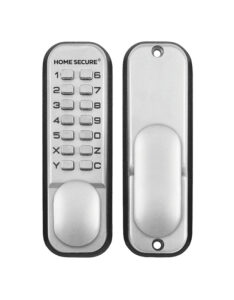
The Home Secure Digital Lock HS13187 is designed to offer a simple and convenient means of providing moderate security for internal or external low to medium traffic areas such as storerooms, workshops, plant rooms and offices. These mechanical units are operated by a push button code of up to six digits. The internal mechanism provides egress by pad lever and the two parts (internal and external sections) are fitted back-to-back through the door to operate a simple tubular latch which is morticed into the door.
The 14-digit keypad offers 8000 codes of four to six digits and the unit is non-handed (suitable for left- and right-handed doors). It boasts a dual function holdback facility and suits doors between 33mm and 55mm thick.
Getting started
Installation of the lock involves first taping the provided template to the door ensuring that the fold mark runs along the edge of the door taking care to use the left- or right-sided template. Drill the three 8mm holes and the 13mm hole for the lock shaft if one is not already in place right through the door.
It may be that there is an existing latch hole in the door so remove the old latch and replace with the new unit. However, if this is a new door then, the latch is fitted by determining the centre point of it using the template and drilling a 25mm hole x 85mm deep. Then push the latch into the hole and draw around the face plate to show where the 3mm rebate should be cut out – this will allow the face plate to sit flush against the edge of the door. The latch can then be secured in place using the supplied wood screws.
The lock shaft needs to be cut to fit the thickness of the door which was a little tricky. We found the easiest way to do this involved putting the shaft into the password box (external panel) and through the two rubber cushions and the backplate and holding at the edge of the door to indicate the place to hacksaw to match the door thickness. Although this sounds more complicated than it was.
The unit is then ready for fitting. Depending on the whether it is a right- or left-side opening door the shaft needs to be inserted in the correct diagonal position in both panels and through the latch. Also, there is a small blue screw on the inside of the backplate that must be in the left hole if a right-handed door and vice versa. The latch support and the extension fittings need to be added to the external panel, then the two panels and rubber cushions can be fixed into place on the door using the two fixing bolts.
Finally, the strike plate needs to be positioned so that it lines up with the flat of the latchbolt – not the plunger. Mark around the edge of the plate and cut a 1mm rebate to enable flush fitting and a recess for the bolt.
Before closing the door for the first time, check that the provided code opens the lock and that the bolt moves as required. Once this is confirmed the door can be closed and the unit is ready for operation.
Read the full review in the August 2025 edition of PSi magazine

